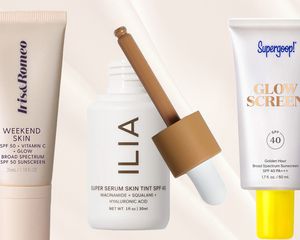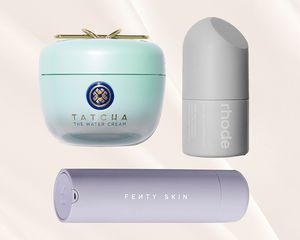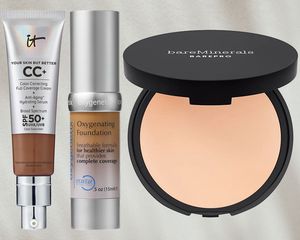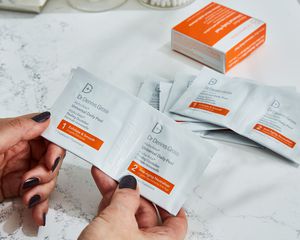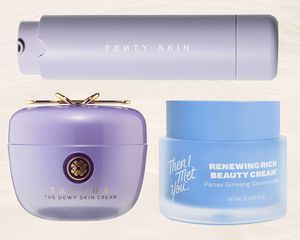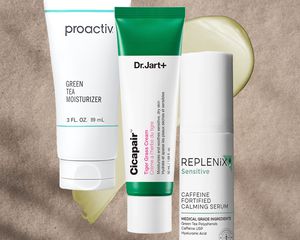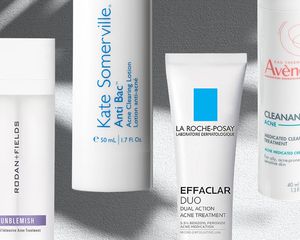:max_bytes(150000):strip_icc()/mineraloil-af35c3fe1ab74dd0bf0abf0b3e6b5591.png)
Stocksy
If you're into skincare, odds are that you've used products with oils in their ingredient list. While oils are most commonly found in, well, oils, they're also very popular amongst moisturizers and cleansers. Oils can range drastically amongst themselves, as they each have different origins and, therefore, different properties. Some can be incredibly moisturizing and therefore have a plumping effect, while others are antiseptic and help treat acne. There are many great oils on the market, but mineral oils have recently gotten a bad rep. So, that begs to question whether or not it's bad for your skin.
One of the main reasons it has a bad reputation is because it's derived from petroleum, which has raised more than a handful of eyebrows in recent years. However, while we believe it's always good to question the safety of what you're putting on your skin, we also recognize there's a lot of fear mongering in the beauty industry.
Mineral oil is used in many cosmetic products, and most dermatologists agree that it's completely safe—and even beneficial—for most skin types. So, to best understand what is it, potential safety concerns, and how to benefit from it, we tapped six experts and asked them to answer all our questions and clear up any confusion. Their insights, below.
Meet the Expert
- Claire Chang, MD, is a board-certified dermatologist at Unionderm in New York City.
- Marnie Nussbaum, MD, is a New York City-based dermatologist.
- Paul Jarrod Frank, MD, is a cosmetic dermatologist and founder of PFRANKMD.
- Joanna Vargas, is a celebrity facialist and founder of the eponymous skincare brand.
- Lindsey Zubritsky, MD, FAAD, is a board-certified dermatologist.
- Gary Goldenberg, MD, a dermatologist and assistant clinical professor at The Icahn School of Medicine at Mount Sinai Hospital in New York City.
- Iris Rubin, MD, dermatologist and founder of SEEN Hair Care.
What Is Mineral Oil?
Simply put, mineral oil is a colorless and odorless petrolatum derivative; when used in cosmetics, it's highly refined and purified and, therefore, does not contain the contaminants that unrefined petroleum has been known for, explains Nussbaum. Still, this is why it's often a no-no in 'clean' formulas. That being said, "Mineral oil has been a mainstay of healing and moisturizing skincare products for decades, including in well-known products such as Vaseline, Aquaphor, and baby oil," points out Chang. Because it's a large molecule, it has limited penetration and instead, sits on top of the skin, as what's known as an occlusive ingredient. This is exactly what makes it a good option in moisturizers—since it traps moisture—but also why it gets a bad rap for being pore-clogging.
Mineral Oil
TYPE OF INGREDIENT: Moisturizer
MAIN BENEFITS: Locks moisture into the skin, softens skin, and improves skin barrier function.
WHO SHOULD USE IT: "I recommend mineral oil for those with dry, sensitive skin, and it can even be used for those with conditions such as eczema or psoriasis," says Claire Chang, MD, a board-certified dermatologist at Unionderm in New York City. She notes that not only is it a good moisturizing ingredient, but it also has a very low risk of allergic reactions or irritation. Mineral oil products aren't recommended for acne-prone skin.
HOW OFTEN CAN YOU USE IT: This depends largely on the specific product you're using and how dry your skin is, but generally speaking, it's fine to use once or twice daily.
WORKS WELL WITH: Humectant ingredients such as glycerin or hyaluronic acid, which attract moisture to the skin, that the mineral oil can then lock in.
DON’T USE WITH: Because it is very occlusive, don't use it with pore-clogging ingredients, notes New York City-based dermatologist Marnie Nussbaum, MD, FAAD, particularly if you start to notice blackheads and whiteheads. (More on whether or not it can clog your pores in a minute.)
More commonly known as petroleum jelly, petrolatum also has a long shelf life, which makes it an often-used ingredient in many skincare and makeup products sold today. Types of products that tend to feature mineral oil in their roster of ingredients include “face creams, body creams, and ointments, as well as eye creams, foundations, liquid makeup removers, and wipes,” says Paul Jarrod Frank, MD, a cosmetic dermatologist and founder of PFRANKMD.
Key Ingredients
Petroleum jelly is composed of natural mineral oils and waxes. It helps seal in moisture, soothe cuts, and accelerate the skin healing process.
Benefits of Mineral Oil for Skin
While mineral oil doesn't have any anti-aging or antioxidant effects on the skin, as many other oils do, it is a choice occlusive and moisturizing ingredient.
- Seals moisture into the skin: Think of mineral oil as creating a barrier between your skin and the outside world, protecting it from outside elements like wind and pollution, says Nussbaum. It's also why it's been shown in studies to reduce trans-epidermal water loss (TEWL), or the loss of water through the skin.
- Smooths and softens skin: Any oil– mineral oil included– should help leave skin feeling softer, as it is meant to slip into the cracks in between cells to create a smoother texture.
- Can be used on skin or hair: The type of mineral oil found in skin and hair care products is graded as safe for consumption by the Food and Drug Administration. “The mineral oil we would find in skincare is typically rated as food-grade,” says Joanna Vargas, celebrity facialist and founder of the eponymous skincare brand.
- Doesn't clog pores: According to our experts, mineral oil itself is non-comedogenic, or not pore-clogging, so using it alone won’t leave your pores filled with added gunk.
- Protects the skin: Due to its naturally occlusive, barrier-creating tendencies, “It is best for people with dry skin as it creates a protective barrier, says Frank. And this protective barrier provides hydration and locks in moisture.
- Available over-the-counter: Unlike some super skincare ingredients, mineral oil products are available in most beauty and drugstores.
Side Effects of Mineral Oil
This is one ingredient that has a low likelihood of causing any kind of skin reaction, says Gary Goldenberg, MD, a dermatologist and assistant clinical professor at The Icahn School of Medicine at Mount Sinai Hospital in New York City. This is why it's often recommended for sensitive skin types. "Dry skin types will benefit the most from using mineral oil as it helps to lock in hydration, repair and protect the skin barrier, and prevent trans-epidermal water loss," says Lindsey Zubritsky, MD, FAAD, is a board-certified dermatologist. "Sensitive skin types may also safely use mineral oil, as it is very unlikely to cause irritation or allergy type reactions."
The big sticking point here is the pore-clogging question. All the derms we spoke with agree that if you're acne-prone or notice more blackheads or whiteheads after using mineral oil-rich products, skip this ingredient.
That being said, "While it's been anecdotally associated with exacerbation of acne in acne-prone patients, human studies have failed to confirm its comedogenicity," says Chang. The bottom line: Proceed with caution if you are prone to pimples, and know that this may not be the best ingredient for you.
However, because mineral oil tends to form a protective layer on the skin, it may trap some other ingredients onto that top layer of the epidermis, which might lead to clogged pores if that ingredient is known to be pore-clogging. “While mineral oil can potentially clog pores, it has a relatively low comedogenicity score in various studies, which is one indicator of propensity to clog pores,” says Iris Rubin, MD, dermatologist and founder of SEEN Hair Care. “It is occlusive though, and can therefore trap other ingredients on the skin, potentially leading to clogged pores.”
Oftentimes, mineral oil is featured as an ingredient in combination with other ingredients within a product. If you have acne-prone skin or have pores that are especially prone to clogging, be sure to check your product labels to see and feel the best results. “It is always important to look at a finished formula to be sure if it is non-comedogenic since the way ingredients combine really matters,” Rubin adds.
That said, the consensus regarding mineral oil is that it’s better left for dry skin types that aren’t prone to acne symptoms, like pimples, blackheads, or cysts.
How to Use Mineral Oil in Your Skincare Routine
"The best time to apply mineral oil is a few minutes after showering when the skin is slightly damp, since mineral oil will help lock some of the moisture into the skin," suggests Chang. And if you're using any other products with moisturizing ingredients, such as hyaluronic acid, or protective actives such as antioxidants, make the mineral oil product the final step in your routine to seal all of that in, she adds. Due to its occlusive nature, mineral oil is an excellent skin protectant for chapped or cracked heels and hands, adds Nussbaum. For those who prefer using an oil to melt off their makeup, Zubritsky says mineral oil can be used as a makeup remover.
If you're looking for a skincare product that contains mineral oil, Zubritsky recommends using Avène's Cicalfate+ Restorative Protective Cream ($28). "It’s a rich cream that not only supports and protects the skin barrier but also contains a unique postbiotic extract to promote a healthy skin microbiome. It can pretty much be used anywhere on anyone, especially those dealing with a damaged skin barrier."
Substitutes for Mineral Oil
If you're still on the fence about mineral oil, you could use castor, olive, and coconut oil as substitutes instead. They have large molecules and naturally occlusive properties similar to mineral oil, but without being derived from petrolatum. For acne-prone skin, opt for grapeseed and avocado oil, which are non-comedogenic options that shouldn't clog pores or result in breakouts.


